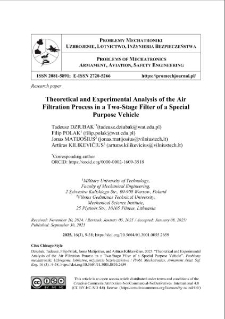Nasza Biblioteka Cyfrowa udostępnia 1 868 obiektów cyfrowych
Obiekt
Tytuł: Theoretical and Experimental Analysis of the Air Filtration Process in a Two-Stage Filter of a Special Purpose Vehicle ; Theoretical and Experimental Analysis of the Air Filtration Process in a Two-Stage Filter of a Special Purpose Vehicle
Tytuł odmienny:
Teoretyczno-eksperymentalna analiza procesu filtracji powietrza w filtrze dwustopniowym pojazdu specjalnego ; Teoretyczno-eksperymentalna analiza procesu filtracji powietrza w filtrze dwustopniowym pojazdu specjalnego
Współtwórca:
Filip POLAK, Jonas MATIJOŠIUS, Artūras KILIKEVIČIUS ; Filip POLAK, Jonas MATIJOŠIUS, Artūras KILIKEVIČIUS
Abstrakt:
Two-stage (multi-cyclone-pore-partition) air filters are what protects a vehicle's engine from sucking in mineral dust particles that cause an accelerated wear of internal components. Information on the air filtration process taking place in a two-stage system (multicyclone-baffle filter) of a vehicle's internal combustion engine is not provided often in the available literature. The purpose of this study was to experimentally evaluate paper filters operating directly behind and without a multicyclone system. An original methodology was used, consisting in testing a single cyclone and a paper filter with a suitably sized surface area. While testing the assembly (cyclone-paper filter test), parameters corresponding to those under which two-stage air filters actually operate were maintained, including filtration speed in the paper filter, dust concentration in the air and the cyclone’s inlet velocity. Filtration efficiency and accuracy, as well as pressure drop value were among the parameters determined as a function of dust mass delivered to the unit (cyclone-paper filter) or directly to the filter. The study showed that a paper filter operating downstream from a cyclone operates four times longer before reaching the permissible pressure drop value. During the initial (short) filtration period, separation efficiency values obtained were much lower (w0 = 93.3% without and wc0 = 53.6% with the cyclone, respectively) than the required threshold of 99.5%. The air behind the paper filter contained dust grains with a size of 35-40 μm, compared to the required parameter of 2-5 μm. Further operation of the filter is characterized by a high separation efficiency of 99.9%, a high accuracy dpmax of 2-5 μm and a continuously increasing pressure drop, with the said drop being more intense in the filter without the cyclone system.
;
Two-stage (multi-cyclone-pore-partition) air filters are what protects a vehicle's engine from sucking in mineral dust particles that cause an accelerated wear of internal components. Information on the air filtration process taking place in a two-stage system (multicyclone-baffle filter) of a vehicle's internal combustion engine is not provided often in the available literature. The purpose of this study was to experimentally evaluate paper filters operating directly behind and without a multicyclone system. An original methodology was used, consisting in testing a single cyclone and a paper filter with a suitably sized surface area. While testing the assembly (cyclone-paper filter test), parameters corresponding to those under which two-stage air filters actually operate were maintained, including filtration speed in the paper filter, dust concentration in the air and the cyclone’s inlet velocity. Filtration efficiency and accuracy, as well as pressure drop value were among the parameters determined as a function of dust mass delivered to the unit (cyclone-paper filter) or directly to the filter. The study showed that a paper filter operating downstream from a cyclone operates four times longer before reaching the permissible pressure drop value. During the initial (short) filtration period, separation efficiency values obtained were much lower (w0 = 93.3% without and wc0 = 53.6% with the cyclone, respectively) than the required threshold of 99.5%. The air behind the paper filter contained dust grains with a size of 35-40 μm, compared to the required parameter of 2-5 μm. Further operation of the filter is characterized by a high separation efficiency of 99.9%, a high accuracy dpmax of 2-5 μm and a continuously increasing pressure drop, with the said drop being more intense in the filter without the cyclone system.
Miejsce wydania:
Warszawa
;
Warszawa
Wydawca:
Wojskowa Akademia Techniczna ; Wojskowa Akademia Techniczna
Data utworzenia:
Data złożenia:
Data akceptacji:
Data wydania:
Rozmiar:
Identyfikator:
oai:ribes-88.man.poznan.pl:2740
Sygnatura:
doi:10.5604/01.3001.0055.2659 ; doi:10.5604/01.3001.0055.2659
ISSN elektroniczny:
ISSN drukowany:
Język:
Licencja:
kliknij tutaj, żeby przejść ; kliknij tutaj, żeby przejść
Właściciel praw:
Wojskowa Akademia Techniczna ; Wojskowa Akademia Techniczna
Strona początkowa:
Strona końcowa:
Tom:
Czasopismo:
Słowa kluczowe:
mechanical engineering, engine, two-stage air filter, paper filter, air separation efficiency and accuracy ; mechanical engineering, engine, two-stage air filter, paper filter, air separation efficiency and accuracy
Kolekcje, do których przypisany jest obiekt:
Data ostatniej modyfikacji:
17 paź 2025
Data dodania obiektu:
17 paź 2025
Liczba wyświetleń treści obiektu:
0
Wszystkie dostępne wersje tego obiektu:
https://ribes-88.man.poznan.pl/publication/3081
Wyświetl opis w formacie RDF:
Wyświetl opis w formacie OAI-PMH:
| Nazwa wydania | Data |
|---|---|
| Theoretical and Experimental Analysis of the Air Filtration Process in a Two-Stage Filter of a Special Purpose Vehicle | 17 paź 2025 |

